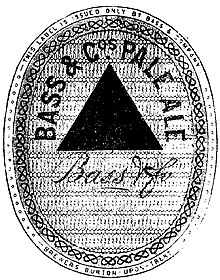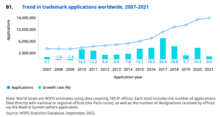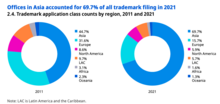Trademark
A trademark (also written trade mark or trade-mark) is a form of intellectual property that consists of a word, phrase, symbol, design, or a combination that identifies a product or service from a particular source and distinguishes it from others.[1][2][3] Trademarks can also extend to non-traditional marks like drawings, symbols, 3D shapes like product designs or packaging, sounds, scents, or specific colors used to create a unique identity.[9][10] Trademark laws vary by jurisdiction but generally allow owners to enforce their rights against infringement, dilution, or unfair competition.[11] International agreements, such as the Paris Convention and the Madrid Protocol, simplify the registration and protection of trademarks across multiple countries.[12][13] Additionally, the TRIPS Agreement sets minimum standards for trademark protection and enforcement that all member countries must follow.[17][18] In the United States, the Lanham Act defines a trademark as any word, phrase, symbol, design, or combination of these things used to identify goods or services.In addition to words, slogans, designs, or combinations of these, trademarks can also include non-traditional marks like sounds, scents, or colors.They should stand out from the surrounding text using capital letters, bold type, italics, color, underlining, quotation marks, or a unique stylized format.[35] It has a much wider meaning and refers to the proprietary visual, emotional, rational, and cultural image that customers associate with a company or product.This proposition has, however, been watered down by the judgment of the House of Lords in the case of Scandecor Development AB v. Scandecor Marketing AB et al. [2001] UKHL 21; wherein it has been held that the mere fact that a bare license (the equivalent of the United States concept of a naked license) has been granted did not automatically mean that a trademark was liable to mislead.[40][41] In contrast, patents have a fixed term, typically lasting 20 years from the filing date,[42][43] after which the invention enters the public domain.Copyrights generally last for the life of the author plus an additional 50 to 70 years (depending on the jurisdiction),[44][45] after which the protected work enters the public domain.[47][48] Around 6,000 years ago, Egyptian masonry featured quarry marks and stonecutters' signs to identify the stone's origin and the workers responsible.[47] Wine amphorae marked with seals were also found in the tomb of Pharaoh Tutankhamun, who ruled ancient Egypt more than 3,000 years ago.[51][52] The first trademark legislation was passed by the Parliament of England under the reign of King Henry III in 1266, which required all bakers to use a distinctive mark for the bread they sold.[9](p29) In contrast, a few countries, like the United States, Canada, and Australia, follow a "first-to-use" or hybrid system, where using the mark in commerce can establish certain rights, even without registration.[73][6] A strong trademark is inherently distinctive (able to identify and distinguish a single source of goods or services), often falling into categories such as suggestive, fanciful, or arbitrary, and is therefore registerable.[73][75] A comprehensive clearance search can help avoid costly and time-consuming issues, such as refusal to register, opposition or cancellation proceedings, or a trademark infringement lawsuit.Each designated country’s trademark office will review the Madrid application under its local laws to grant or refuse protection.[86][85] Unlike patents and copyrights, which have fixed expiration dates, trademark registrations typically have an initial term of 10 years and can be renewed indefinitely,[38][39][87] as long as the mark remains in continuous use in commerce.[89] Similarly, the European Union requires "genuine use" of the mark within a continuous five-year period following registration to maintain the trademark, with non-use potentially resulting in revocation.[8][97] This concept is recognized in many jurisdictions, including the United States, the European Union, and other countries, though specific legal standards may vary.In a related sense, an auto mechanic can truthfully advertise that he services Volkswagens,[100] and a former Playboy Playmate of the Year can identify herself as such on her website.The licensor must monitor the quality of the goods being produced by the licensee to avoid the risk of the trademark being deemed abandoned by the courts.Even though initial interest confusion is dispelled by the time any actual sales occur, it allows a trademark infringer to capitalize on the goodwill associated with the original mark.Also, courts have upheld the rights of trademark owners about the commercial use of domain names, even in cases where goods sold there legitimately bear the mark.Most jurisdictions have since amended their trademark laws to address domain names specifically and to provide explicit remedies against cybersquatters.Amazon is a prime example of a protected trademark for a domain name central to the public's identification of the company and its products.Under Article 6 bis of the Paris Convention,[117] countries are empowered to grant this status to marks that the relevant authority considers are "well known".It is, nevertheless, advisable to seek registration, taking into account that many countries provide for extended protection of registered well-known marks against dilution (Art.







Trademark (disambiguation)TrademarcIntellectual propertyAuthors' rightsCopyleftCopyrightDatabase rightFarmers' rightsGeographical indicationIndigenous intellectual propertyIndustrial design rightIntegrated circuit layout design protectionMoral rightsPatentPeasants' rightsPlant breeders' rightsPlant genetic resourcesRelated rightsSupplementary protection certificateTrade dressTrade secretUtility modelAbandonwareArtificial intelligence and copyrightBrand protectionCopyright abolitionCopyright trollCriticism of copyrightBioprospectingBiopiracyIdea–expression distinctionLimitations and exceptions to copyrightFair dealingFair useParaphrasingRight to quoteOrphan workPatent trollPirate PartyPublic domainOutline of intellectual propertyOutline of patentsPropertyProperty lawproductserviceUnited States Patent and Trademark OfficeEuropean Union Intellectual Property OfficeParis ConventionMadrid ProtocolTRIPS AgreementLanham ActWorld Intellectual Property OrganizationBurberry Ltd.non-traditional marksENERGY STAREnvironmental Protection AgencyRegistered trademark symbolTrademark symbolpublic policyconsumer protectionquality controlFunctionality doctrineThreshold of originalitypatentscopyrightsCoca-ColaLet It GoFrozengenericidePrehistoryLascauxamphoraePharaoh Tutankhamunancient EgyptStella ArtoisLöwenbräuParliament of EnglandHenry IIIMerchandise Marks Act 1862Trade Marks Registration Act 1875prima facieUnited StatesCongressCopyright ClauseTrade-Mark CasesCommerce ClauseTrade Marks Act 1938United KingdomBass BreweryAustraliaSouth AustraliaQueenslandTasmaniaNew South WalesVictoriaWestern AustraliaBank of New South WalesFederation of AustraliaSamsonGermanyTrademark distinctivenessGlobal Brand DatabaseMadrid SystemU.S. Patent and Trademark OfficeL'OrealFranceBayerische Motoren Werke AGBulgariaBoehringer Ingelheim International GmbHNovartisBerlin-Chemie AGShiseidoMizuno CorporationHuaweicustomsOppositionCease-and-desistTrademark infringementlimitations on geographic scopeFirst Amendmentthe trademark owned by Linus TorvaldsMaytagVolkswagensPlayboyPlaymate of the Year